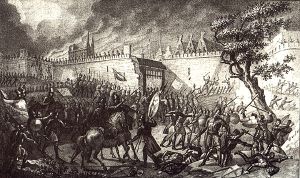Livonian War
| Polish–Russian Wars |
|---|
Kiev Expedition – Muscovite/Lithuanian – Livonian – 1605–18 – Smolensk – 1654–67 – War of the Polish Succession – Bar Confederation – 1792 – Kościuszko Uprising – November Uprising – January Uprising – Polish/Soviet – 1939 |
Template:Polish-Swedish Wars Template:Russo–Swedish War Series The Livonian War of 1558–1582 was a lengthy military conflict between the Tsardom of Russia and variable coalition of Denmark, Grand Duchy of Lithuania, Kingdom of Poland (later the Polish-Lithuanian Commonwealth), and Sweden for control of Greater Livonia (the territory of the present-day Estonia and Latvia).
By the late 1550s, the Reformation and Counter-Reformation had caused internal conflicts in Livonian Confederation, while its Eastern neighbour Russia had grown stronger after defeating the khanates of Kazan and Astrakhan. The conflict between Russia and the Western powers was exacerbated by Russia's isolation from sea trade. Neither could the tsar hire qualified labour in Europe.
In 1547 Hans Schlitte, the agent of Tsar Ivan IV, employed handicraftsmen in Germany for work in Russia. However all these handicraftsmen were arrested in Lübeck at the request of Livonia.[1] The German Hanseatic League ignored the new port built by tsar Ivan on the eastern shore of the Narva River in 1550 and still delivered the goods still into ports owned by Livonia.[2]
Tsar Ivan IV demanded that the Livonian Confederation pay 40,000 talers for the Bishopric of Dorpat, based on a claim that the territory had once been owned by Russian Novgorod Republic. The dispute ended with a Russian invasion in 1558. Russian troops occupied Dorpat (Tartu) and Narwa (Narva), laying siege to Reval (Tallinn). The goal of Tsar Ivan was to gain vital access to the Baltic Sea.
Tsar Ivan's actions conflicted with the interests of other countries. In the wake of the disastrous Battle of Ergeme, the weakened Order of Livonia was dissolved (Wilno/Vilnius Pact, 1560), while its lands were assigned to the Grand Duchy of Lithuania united with Poland (Ducatus Ultradunensis), and the rest to Sweden (Northern Estonia), and to Denmark (Ösel). The last Master of the Order of Livonia, Gotthard Kettler, became the first ruler of the Polish and Lithuanian (later Polish-Lithuanian Commonwealth) vassal state Duchy of Courland.
Erik XIV of Sweden and Frederick II of Denmark sent troops to protect their newly-acquired territories. In 1561, the city council of Reval surrendered to Sweden, and became the outpost for further Swedish conquests in the area. By 1562, Russia found itself in wars with Lithuania and Sweden. In the beginning, the Tsar's armies scored several successes, taking Polotsk (1563) and Pernau (Pärnu) (1575), and overrunning much of Lithuania up to Vilnius, which led him to reject peace proposals from his enemies.
However the Tsar (called The Terrible) found himself in a difficult position by 1579. The Crimean Tatars devastated Russian territories and burnt down Moscow (see Russo-Crimean Wars), the drought and epidemics have fatally affected the economy, and Oprichnina had thoroughly disrupted the government, while Lithuania had united with Poland (new union in 1569) and acquired an energetic leader, king Stefan Batory. Not only did Batory reconquer Polotsk (1579), but he also seized Russian fortresses at Sokol, Velizh, Usvzat, Velikie Luki (1580), where his soldiers massacred all Russian inhabitants[3], and laid siege to Pskov (1581–82). Polish-Lithuanian cavalry devastated the huge regions of Smolensk, Chernigov, Ryazan, southwest of the Novgorodian territory[4] and even reached the Tsar's residences in Staritsa. Ivan prepared to fight, but Poles retreated[5]. In 1581, a mercenary army hired by Sweden and commanded by Pontus de la Gardie captured the strategic city of Narva and massacred its inhabitants, 7,000 people [6].
These developments led to the signing of the peace Treaty of Jam Zapolski in 1582 between Russia and the Polish-Lithuanian Commonwealth in which Russia renounced its claims to Livonia. The Jesuit papal legate Antonio Possevino was involved in negotiating that treaty. The following year, the Tsar also made peace with Sweden. Under the Treaty of Plussa, Russia lost Narva and the southern coast of the Gulf of Finland, being its only access to the Baltic Sea. The situation was partially reversed 12 years later, according to the Treaty of Tyavzino which concluded a new war between Sweden and Russia.
ReferencesISBN links support NWE through referral fees
- ↑ Karamzin N.M. "The History of Russia", volume VIII (Documents from the Archive of Koenigsberg)
- ↑ "The Full Collection of Russian Annals", vol. 13, SPb, 1904
- ↑ Sergey Solovyov. History of Russia from the Earliest Times, ISBN 5-17-002142-9, v.6, p.872
- ↑ Rheinhold Heidenstein. "The Notes about the Moscow war". (1578–1582), SPb, 1889
- ↑ Sergey Solovyov. History of Russia from the Earliest Times, ISBN 5-17-002142-9, v.6
- ↑ Sergey Solovyov. History of Russia from the Earliest Times, ISBN 5-17-002142-9, v.6, p.881
| ||||||||||||||||||||||||||||
- This article is based on material from the public domain 1906 Brockhaus and Efron Encyclopedic Dictionary.
be:Лівонская вайна, 1558-1583
be-x-old:Лівонская вайна
bg:Ливонска война
de:Livländischer Krieg
et:Liivi sõda
es:Guerra Livona
fr:Guerre de Livonie
id:Perang Livonia
it:Prima guerra del nord
lv:Livonijas karš
lt:Livonijos karas
hu:Livóniai háború
nl:Lijflandse Oorlog
ja:リヴォニア戦争
no:Livlandskrigen
pl:Dominium Maris Baltici
pt:Guerra da Livônia
ru:Ливонская война
fi:Liivinmaan sota
sv:Livländska kriget
tr:Livonya Savaşı
Credits
New World Encyclopedia writers and editors rewrote and completed the Wikipedia article in accordance with New World Encyclopedia standards. This article abides by terms of the Creative Commons CC-by-sa 3.0 License (CC-by-sa), which may be used and disseminated with proper attribution. Credit is due under the terms of this license that can reference both the New World Encyclopedia contributors and the selfless volunteer contributors of the Wikimedia Foundation. To cite this article click here for a list of acceptable citing formats.The history of earlier contributions by wikipedians is accessible to researchers here:
The history of this article since it was imported to New World Encyclopedia:
Note: Some restrictions may apply to use of individual images which are separately licensed.



